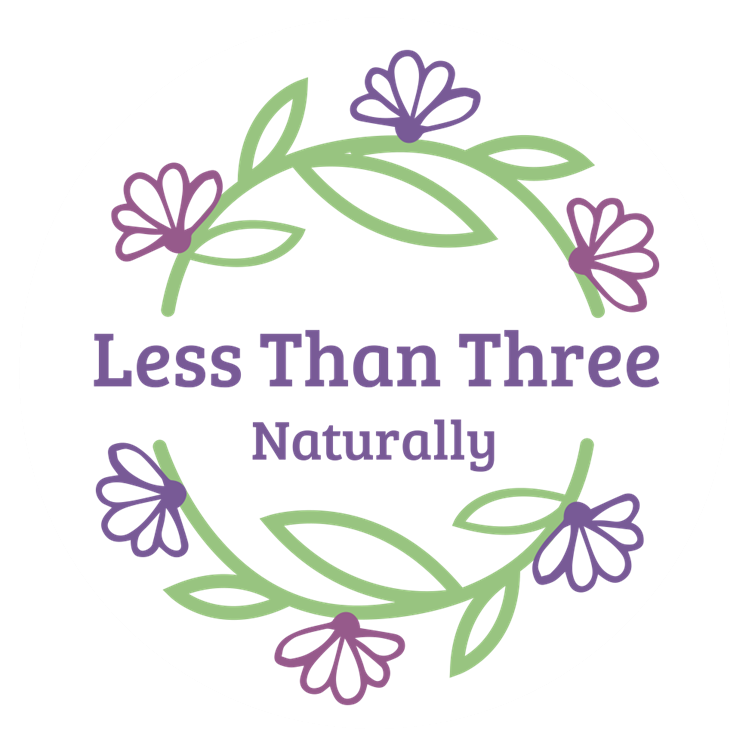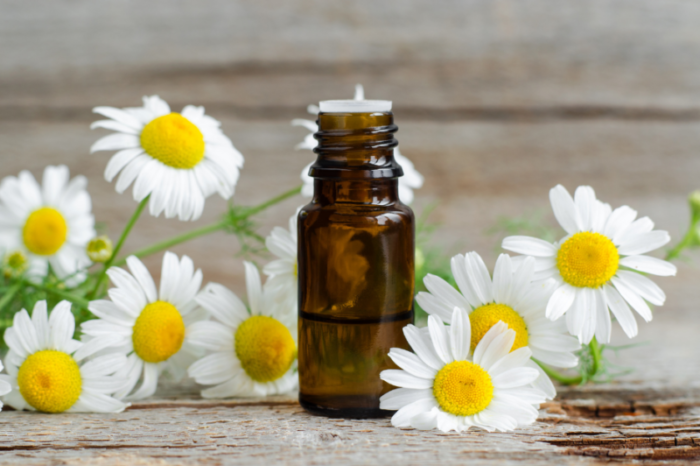Less Than Three – Naturally uses chamomile extract, essential oil and hydrosol in our products. There are several varieties of Chamomile, all relatives of the daisy, growing around the world. The two most sought-after for their medicinal benefits are German Chamomile (known as Chamomilla chamomilla, Chamomilla recutita or Matricaria recutita) which is usually blue and Roman Chamomile (Anthemis nobilis), yellow. Although both herbs belong to the Asteraceae/Compositae family and they are used to treat similar health problems, they have a different chemical composition.
Chamomile is traditionally considered to be an antiseptic, antibacterial, antifungal and anti-inflammatory plant. It has been used throughout history in embalming oils and skincare in ancient Egypt. There are also records of it being used by the Greeks and Romans in medicine, drinks and incense. In the Middle Ages, chamomile and other herbs such as lavender were strewn on the floors of gathering places to improve the smell. Today, chamomile is primarily used in remedies as an antispasmodic for digestive issues and for wound healing. Emerging research has begun to identify other potential benefits, like its ability to help with depression, anxiety, and sleep by being used as a sedative and to treat anxiety. It has also been used on cuts and wounds, as a treatment for mild skin irritation and inflammation and even to lighten blonde hair.
🌼German Chamomile, chamomilia recutita:
The extract we use is a glycerite; extracted from organic German Chamomile, chamomilia recutita plant matter in glycerine. Glycerites are used extensively in herbalism as alcohol-free tinctures. Their benefit comes both from the extracts of the plant matter macerated in the glycerine and from the glycerine itself which is an excellent humectant (an ingredient that hydrates by attracting water).
It contains chamazulene which has been the subject of extensive research. It is considered to have anti-allergy and anti inflammatory properties with a history of use in the treatment of skin problems. It gives German chamomile its characteristic blue colour.
It also contains a second anti-inflammatory compound called alpha-bisabolol that has anti-irritant and anti-microbial properties. It has been used to maintain normal skin; calm dry, irritated or flaky skin, and promote healing and regeneration of damaged skin tissue.
🌼 Roman Chamomile, anthemis nobilis:
The essential oil and hydrosol we use come from organic dried flowers of the Roman Chamomile, anthemis nobilis plant during a steam distillation process.
Due to its anti-inflammatory and antibacterial properties, chamomile is thought to help calm skin inflammation and redness and promote smooth, healthy skin. It is used as an antioxidant and anti-inflammatory which makes it good for night time creams, baths or pulse point formulas.
Chamomile has also been used to help reduce redness and is known to be soothing on inflamed skin and it is particularly suited to sensitive skins that are prone to inflammation and the treatment of blemishes. It is also thought to be high in antioxidants, which is great for helping mature skin look more radiant.
References:
Harmatova, B. (2021). Formulator’s Guide to Glycerites in Skincare. [online] Formula Botanica. Available at: https://formulabotanica.com/making-glycerites-fresh-food/ [Accessed 6 Feb. 2022].
Herb & Hedgerow. (2013). Chamomile – Uses in Natural Beauty & Skincare. [online] Available at: http://www.herbhedgerow.co.uk/chamomile-uses-in-natural-beauty-skincare/ [Accessed 6 Feb. 2022].
Sharafzadeh, S., Alizadeh, O. and Chamomile, R. (n.d.). Journal of Applied Pharmaceutical Science, [online] (10), p.1. Available at: https://www.japsonline.com/admin/php/uploads/288_pdf.pdf. [Accessed 6 Feb. 2022].
Seladi-Schulman, J. (2019). The 8 Proven Benefits of Chamomile Oil and How to Use It. [online] Healthline. Available at: https://www.healthline.com/health/chamomile-oil. [Accessed 6 Feb. 2022]
Healthline. (2021). 7 Ways to Soothe Your Skin With The Benefits of Chamomile. [online] Available at: https://www.healthline.com/health/beauty-skin-care/chamomile-benefits-for-skin#skin-benefits [Accessed 6 Feb. 2022].
www.sciencedirect.com. (n.d.). Chamazulene – an overview | ScienceDirect Topics. [online] Available at: https://www.sciencedirect.com/topics/medicine-and-dentistry/chamazulene [Accessed 29 Mar. 2022].
Healingscents (n.d.). Compare German vs Roman Chamomile Essential Oils. [online] Healingscents. Available at: https://healingscents.net/blogs/learn/compare-german-blue-vs-roman-chamomile-essential-oils#:~:text=Roman%20Chamomile%20has%20a%20light [Accessed 29 Mar. 2022].
Wikipedia. (2021). Bisabolol. [online] Available at: https://en.wikipedia.org/wiki/Bisabolol. [Accessed 29 Mar. 2022].
Anon, (2020). Roman vs German: Exploring the world of Chamomile | Sibelius. [online] Available at: https://www.sibeliusnaturalproducts.com/the-eternal-battle-between-roman-and-german-chamomile/ [Accessed 29 Mar. 2022].
Healthline. (2019). The 8 Proven Benefits of Chamomile Oil and How to Use It. [online] Available at: https://www.healthline.com/health/chamomile-oil#benefits [Accessed 29 Mar. 2022].

